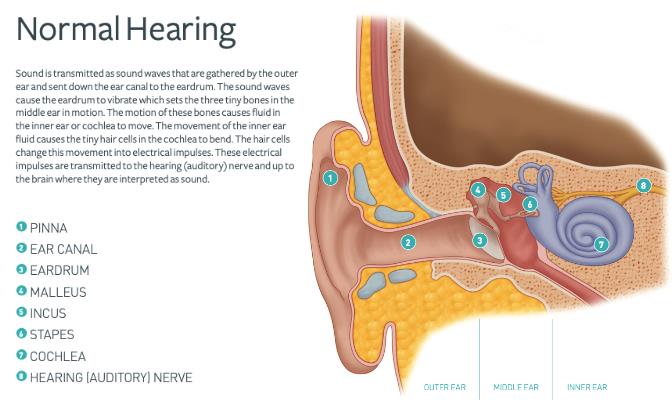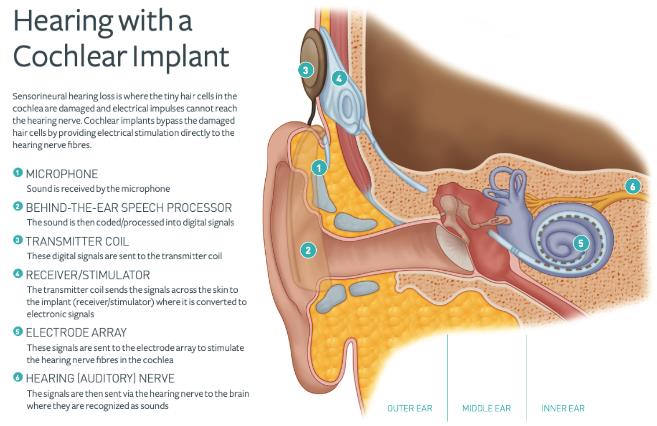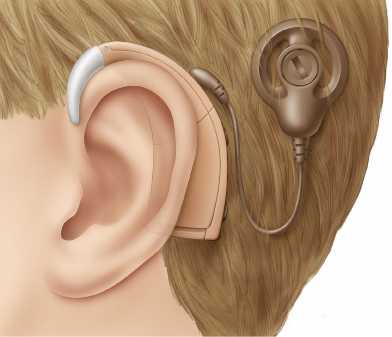Cochlear Implants
What is a cochlear implant?
A cochlear implant is a device which can improve access to sound for some people who do not get useful benefit from conventional acoustic hearing aids. Cochlear implants are appropriate for both adults and children with severe to profound hearing impairment in both ears.
A cochlear implant is an electronic device which is made up of two components: the internal component is inserted into the inner ear (cochlea) during an operation; the external component is called a speech processor and is worn on the head or body, like a hearing aid.
How does a cochlear implant work?
Within the cochlea there are thousands of hair cells which transfer sound waves in to nerve impulses to be sent up the hearing nerve to the brain. In many severe and profound hearing losses these hair cells are damaged and do not provide effective stimulation to the hearing nerve, even when sounds are made louder, therefore conventional hearing aids do not provide adequate access to sound. A cochlear implant provides a sensation of hearing by using electrical stimulation to bypass the damaged hair cells and stimulate the hearing nerve directly.
Cochlear implantation can greatly improve quality of life by providing better access to sound, however, it is important to note that the signal received from the implant is not the same as normal hearing. People who receive cochlear implants require time and training to become accustomed to the sound. Ongoing rehabilitation is required after implantation to get the most benefit from the device, especially in the case of young children who may never have heard before.


The external parts
The speech processor is often worn behind the ear like a hearing aid but can also be worn off the ear on the head or clipped to clothing. It has a microphone which picks up incoming sounds. The useful features of the incoming sound are then converted into a digital signal. The other external parts consist of a cable, transmitting coil and magnet. The cable connects the speech processor to the transmitting coil. The magnet holds the transmitting coil in place and allows it to send the signal across the skin to the internal component of the cochlear implant, called a receiver-stimulator. In some cases, the speech processor is worn on the head and uses a coil and magnet all in one unit to stimulate the internal device, in this case there is no cable.
There are several manufacturers of cochlear implants and the type of speech processor the patient uses depends on the cochlear implant system they have and their own preference.
Image provided by Cochlear Europe Ltd
The Internal Parts
The internal part of the cochlear implant is inserted during an operation and is made up of two components, the receiver-stimulator and an electrode array.
The receiver-stimulator package receives information from the transmitting coil worn on the head and sends it to the electrode array. The electrode array has a series of small metal contacts (electrodes) which deliver the signal directly to the hearing nerve using a series of small electrical impulses. The different electrodes provide stimulation for different pitches of sound. The hearing nerve then carries the information to the brain, where it is interpreted as sound.
What does a cochlear implant sound like?
A cochlear implant, once implanted and tuned, does not sound the same as normal hearing. Our patients need to work on their listening skills for a while before they can hear and communicate well. Some take longer than others. It’s is not possible to replicate the sound accurately as this is experienced differently and depends on a variety of factors. If you are interested to know more about this click here.
More Information
More information about cochlear implants can be found below (some of these links are to pages on this website):
British Cochlear Implant Group Website
The following link takes you to a range of leaflets which can provide you with more information about our products and services
The link below will help a patient to choose which implant and processor would work best for him or her.
Once a patient has been implanted with a cochlear implant and their processor has been tuned, the Auditory Implant Service team will provide continued and regular support.


